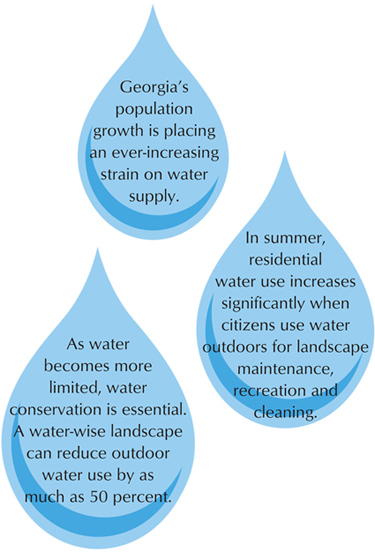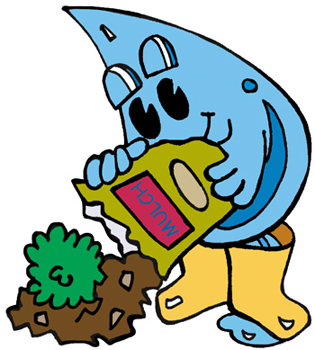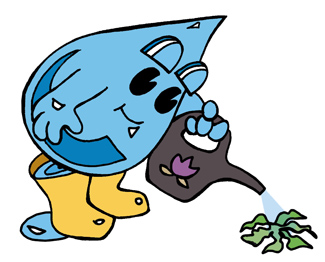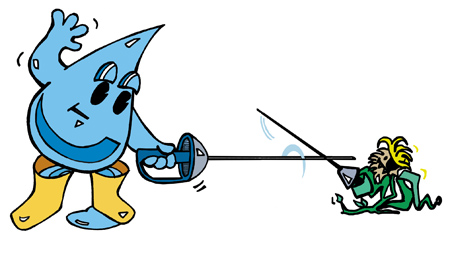
Water-wise landscapes not only save water, they save time by requiring less routine care than most traditional landscapes. Plants in a water-wise landscape are carefully selected for the site and grouped together according to their water needs. Then cultural practices are used to maximize the soil's ability to hold water and to minimize water loss. When a landscape achieves water-wise status, at least 60 percent of the total landscaped area is considered "low water use" and watered exclusively by Mother Nature.
One goal in managing a water-wise landscape is to minimize new vegetative growth. Lush new growth is the first to wilt when water becomes limited. New leaf growth also increases the demand on the roots for water and nutrients, which is a problem during periods of limited rainfall. Generally, the more we stimulate plants to grow, the more care they require, and the more resources are required to maintain them.
Another goal in managing a water-wise landscape is to conserve moisture in the soil and reduce evaporative water loss.
This publication offers guidelines to help you achieve these goals and conserve water when managing your landscape.

Mulching Is a Must!
Mulch is a great asset in a water-wise landscape. Organic mulches such as pine straw, pine bark mulch or shredded hardwood mulch conserve water. These fine-textured mulches hold moisture in the soil, yet they are porous enough to allow water to infiltrate into the soil. Unfortunately, organic mulches decompose, shrink in volume and need replenishing regularly.
For best water conservation, maintain 3 to 5 inches of mulch on the soil surface at all times. Generally, one bale of pine straw covers 50 square feet when applied to a 5-inch depth. One cubic yard (14, 2 cu. ft. bags) of bark mulch covers 100 square feet to a 3-inch depth.
Several municipalities and power companies collect and grind wood brush left curbside by citizens, then make it available as mulch.
Drip Is Dandy on Flowers
An efficient way to water annual flowers, roses and herbaceous perennials is with drip irrigation tubing or ooze hose. The hose can be woven in a serpentine fashion throughout the bed and placed under the mulch. Drip irrigation avoids spraying the foliage so it does not encourage disease. It also applies water directly to the roots, so there is less evaporative loss of water.
Less Is More When Fertilizing
Most established healthy trees and shrubs only need fertilizer once every two to three years. Most established herbaceous perennials perform well when fertilized every other year. If you do a good job of building up organic matter in the soil, plants can extract essential mineral elements they need from the soil and will not require annual fertilization. Annual flower and roses are exceptions — they require regular feeding to grow and flower well.
Nitrogen, the first number in a fertilizer analysis, stimulates new growth, and new growth is the first to wilt during periods of limited rainfall. Furthermore, when shoot growth increases, root growth decreases, so the roots are less efficient at extracting moisture from the soil. When selecting a fertilizer for ornamental plants, look for one that is less than 15 percent nitrogen. Then apply it at a low rate (a low rate would be 1 pound of actual nitrogen per 1,000 square feet).
To calculate the application rate, divide the first number in the analysis into 100. For instance, a 12-4-8 fertilizer would be applied at a rate of 8 pounds per 1,000 square feet (100/12 = 8.3 or 8, rounded off).
Never fertilize during dry periods because fertilizers are chemical salts and may dehydrate roots. Also, never fertilize prior to rainfall, because heavy rain may wash valuable nutrients down the storm drain into rivers and streams where they can become pollutants.
The best time to fertilize ornamental plants in the landscape is when spring growth begins. Research shows that plants absorb more fertilizer when they are actively growing, and they absorb little to no fertilizer when they are dormant. Fall fertilization is not recommended because it has been shown to decrease winter hardiness of some plants.
Aeration Helps the Flow
Turfgrass specialists recommend aerating lawns at least once a year. A lawn aerator makes holes in the turfgrass approximately 2 to 4 inches deep and ½ inch wide. Aeration improves the percolation and movement of water and nutrients into the soil, decreases runoff and encourages the roots of turfgrass to grow deeply and to become more drought tolerant.

Water Only Plants that Need It
Water those plants that show signs of moisture stress. Plants under moisture stress turn a gray-green color or wilt.
When hand watering, make certain you apply water slowly at a rate the soil can absorb. Use a water-breaker on the hand-held hose to soften the impact of the water on the ground. If water starts running off the site, you are applying it too rapidly. Either turn down the pressure or make several passes with the hand-held hose over the same area to give soil time to absorb the water.
Let the Clips Fall Where They May
Grasscycling is the process of leaving clippings on the lawn at each mowing instead of bagging them. Research shows clippings work their way back into the grass. They act like a mulch at the soil surface, helping reduce moisture loss from the soil.
Grasscycling also recycles as much as 30 percent of the nitrogen applied to the lawn back to the grass as clippings decompose.
The key is to mow often enough so the clippings remain small and move readily back into the grass.

Keep Weeds at Bay
Weeds not only make the landscape unattractive, they compete with plants for moisture and nutrients. Although mulch helps prevent weeds, inevitably some hand weeding or herbicide spraying is necessary. Some garden centers sell pre-emergent herbicides that prevent annual weeds from sprouting from seed. These are normally applied in late winter to prevent spring and summer weeds and again in late summer to prevent fall and winter weeds. Landscape fabrics, available in some garden centers, can be placed under mulch to serve as an added barrier to weeds.
When in Doubt, Don't Cut It Out!
Root growth depends on food substances produced via photosynthesis. The more green tissue a plant has, the more food it produces for promoting root growth. Summer pruning not only removes green leaf tissue and reduces photosynthesis, it diverts the plant's energy into new shoot growth at the expense of root growth. By minimizing summer pruning, the plant's energy can be directed to root growth, and the more roots a plant has, the efficient it is at absorbing moisture from the soil.
Exceptions to the summer pruning rule are pruning done to remove dead, diseased or damaged wood and pruning done in an effort to save a plant suffering from drought stress. When a plant wilts during severe drought stress, survival pruning may be necessary. This involves pruning back the plant canopy by one-third or more to reduce the leaves' demand on the roots for moisture. Survival pruning during extreme drought may be the difference between life and death for some drought sensitive plants.
Make Every Drop Count ... Our Future Depends on It!
For additional information on saving water in the landscape, see Georgia Cooperative Extension Bulletin 1073, Xeriscape: A Guide to Developing a Water-Wise Landscape. Also visit the Georgia Cooperative Extension drought Web site or contact your local county Cooperative Extension office by calling 1-800-ASK-UGA1.
Endorsed by:

Status and Revision History
Published on Feb 28, 2007
Published on Sep 14, 2009
Published with Full Review on Sep 01, 2012
Published with Full Review on Aug 07, 2017


























































